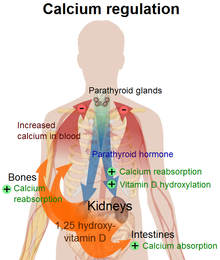|
Vitamin D and Calcium: You Need them Both
Vitamin D and calcium are both needed for a strong skeletal system, heart and muscles. They are both so important for your health that you body produces and stores them both … and when you run low it can cause a lot of health problems, as we've chronicled elsewhere in our website.
Vitamin D is best known for promoting bone health. It was first added to the milk supply in the 1930s to prevent the bone-deforming disease rickets, and it defends against osteoporosis by triggering the absorption of calcium into bone cells. New evidence indicates that many people suffering symptoms of chronic fatigue syndrome and fibromyalgia actually have a painful softening of the bones that is caused by a D deficiency. The body needs vitamin D to absorb calcium. Without enough vitamin D, one can’t form enough of the hormone calcitriol (known as the “active vitamin D”). This in turn leads to insufficient calcium absorption from the diet. In this situation, the body must take calcium from its stores in the skeleton, which weakens existing bone and prevents the formation of strong, new bone. You can get vitamin D in three ways: through the skin, from the diet, and from supplements (all of which are described in detail in the section entitled: The Sunshine Vitamin). Note: Several studies suggest that a higher dietary intake of vitamin D and calcium correlates with lower incidence of cancer.
Calcium is important for bones because it is a major component of bones, which are constantly being broken down and built back up. Vitamin D regulates calcium absorption and excretion, especially when calcium intake is low. Calcium is also needed in the blood to keep muscles, such as the heart, contracting efficiently. The body preserves blood calcium levels at the expense of bone calcium. When calcium levels in the blood drop, parathyroid hormone (PTH) is released. PTH causes calcium to be released from the bones, thus raising the low calcium levels in the blood. Osteoporosis may result from chronically high levels of PTH. 
Vitamin D is the building block of the hormone calcitriol which works synergistically with PTH. Vitamin D is modified by the liver to become 25-hydroxyvitamin D (also known as 25(OH)D). 25(0H)D is then modified in the kidneys to become calcitriol. This conversion is somewhat regulated by PTH levels. Calcitriol increases absorption of calcium and phosphorus (another major component of bones) from the intestines and decreases their excretion in the urine. In so doing, calcium levels in the blood rise and PTH levels drop. Calcitriol has many other functions. How the body regulates the processes of conversion of vitamin D into calcitriol and the resulting net increase or decrease of bone calcium are not fully known.
Most Americans seem to be getting enough calcium, whereas vitamin D is a bigger concern. A 2003 report from the Nurses Health Study showed vitamin D to be more important than calcium intake for preventing hip fractures in postmenopausal women. In 2007, a meta-analysis of prospective studies and randomized controlled trials found that calcium intake and calcium supplements by themselves did not lower the risk for hip fractures. In addition to people being more likely to be deficient in vitamin D than calcium, vitamin D also appears to be more important for bones in conjunction with lower calcium intakes (typical in most vegan diets) than in diets that have large amounts of calcium. Bottom line: the researchers concluded that it is the combination of vitamin D and calcium, rather than vitamin D alone, that is most effective in reducing a variety of fractures. Source: (NaturalNews)
Remember, a balanced diet rich in vitamin D and calcium is only one part of an osteoporosis prevention or treatment program. Like exercise, getting enough calcium is a strategy that helps strengthen bones at any age. But these strategies may not be enough to stop bone loss caused by lifestyle, medications, or menopause. Your doctor can determine the need for an osteoporosis medication in addition to sunshine, diet, exercise and supplements.
Vitamin D is important for good health and long-life. Here are some of the articles we've added to our website to give you a full picture of this important subject. Like other parts of this website these articles summarize the important facts and include useful advice. If Vitamin D Were a Drug It Would Win the Nobel Prize Vitamin D Deficiency: Causes and Risk Factors Learn to recognize the symptoms of vitamin D deficiency, especially in women and children Testing Your Vitamin D Levels: (know what to ask your doctor, or order a home testing kit) Getting Vitamin D from Sunshine What you need to know when choosing a Vitamin D supplement Vitamin D Deficiency is linked to 2/3rds of the medical problems in the US along with poor diet VVitamin D helps prevent 3 out 4 cancers Vitamin D is Important for Good Heart Health Vitamin D deficiency can cause mobility problems
The information contained in this section of our web site is for educational purposes and is not intended as medical advice. While the publishers of this website believe that people have the right to understand their own bodies and to take care of their bodies as they see fit, we also respect the knowledge and experience of trained nutritionists, scientists, researchers, medical practioners, and others who can help you achieve the optimum health you are entitled to, and suggest you seek out and work with health specialists you can trust.
Click on the highlighted word to return the top of this section on Vitamin D and Calcium or to return to the first introductory article about Vitamin D.
|


